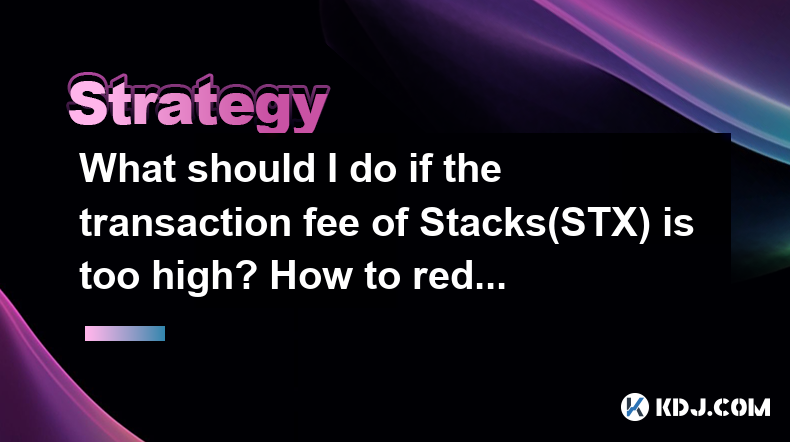-
 bitcoin
bitcoin $115692.075601 USD
5.13% -
 ethereum
ethereum $4162.931611 USD
11.68% -
 bnb
bnb $1310.063287 USD
17.56% -
 tether
tether $1.000983 USD
0.00% -
 xrp
xrp $2.534505 USD
8.16% -
 solana
solana $198.235737 USD
13.49% -
 usd-coin
usd-coin $1.000236 USD
0.02% -
 dogecoin
dogecoin $0.207352 USD
12.89% -
 tron
tron $0.323043 USD
3.62% -
 cardano
cardano $0.701559 USD
11.88% -
 hyperliquid
hyperliquid $39.924597 USD
8.30% -
 chainlink
chainlink $18.934457 USD
11.56% -
 ethena-usde
ethena-usde $1.000552 USD
0.02% -
 stellar
stellar $0.340575 USD
7.05% -
 bitcoin-cash
bitcoin-cash $545.011757 USD
8.86%
What should I do if the transaction fee of Stacks(STX) is too high? How to reduce the transaction cost?
To reduce high Stacks (STX) transaction fees, monitor network congestion, batch transactions, adjust priority, use fee-optimized wallets, and explore layer-2 solutions.
May 01, 2025 at 09:07 am

If you're finding that the transaction fees for Stacks (STX) are too high, there are several strategies you can employ to reduce your costs. Understanding the factors that influence these fees and learning how to manage them effectively can significantly lower your expenses. Let's delve into the details of how you can tackle high transaction fees on the Stacks blockchain.
Understanding Stacks Transaction Fees
Stacks (STX) operates as a layer-1 blockchain that is designed to enable smart contracts and decentralized applications (dApps) on Bitcoin. The transaction fees on Stacks are determined by several factors, including network congestion, the size of the transaction, and the priority you set for your transaction.
When the network is busy, miners prioritize transactions with higher fees, which can drive up the cost. The size of your transaction, measured in bytes, also affects the fee, as larger transactions require more space on the blockchain. Additionally, setting a higher priority for your transaction can result in faster processing but at a higher cost.
Strategies to Reduce Stacks Transaction Fees
There are several practical steps you can take to reduce the transaction fees when using Stacks. Here’s how you can go about it:
1. Choose the Right Time to Transact
One effective way to reduce fees is to monitor the network congestion. During periods of low activity, transaction fees tend to be lower. You can use blockchain explorers or analytics platforms to check the current state of the Stacks network.
- Visit a Stacks blockchain explorer like Hiro or Stacks Explorer.
- Look for the current transaction volume and fee estimates.
- Plan your transactions during times when the network is less congested.
2. Optimize Transaction Size
Reducing the size of your transaction can also help lower fees. This involves:
- Batching transactions: Instead of sending multiple small transactions, you can batch them into one larger transaction. This reduces the overall byte size and, consequently, the fee.
- Using SegWit addresses: If available, using SegWit addresses can reduce the size of your transaction, as they separate signature data from the transaction data.
3. Adjust Transaction Priority
You have the option to set the priority of your transaction, which influences the fee. Here's how to do it:
- Low priority: Choose a lower fee if you are not in a hurry. This can significantly reduce costs, though it may take longer for your transaction to be processed.
- Customize fees: Some wallets allow you to manually set the fee. Use fee estimation tools to find an optimal balance between cost and speed.
4. Use a Wallet with Fee Optimization Features
Selecting the right wallet can make a big difference in managing fees. Some wallets come with features designed to optimize transaction costs:
- Hiro Wallet: This wallet offers tools to estimate and adjust fees based on current network conditions.
- Xverse Wallet: Another option that provides fee optimization features, allowing you to choose the most cost-effective settings for your transactions.
To use these features:
- Download and install the wallet of your choice.
- When initiating a transaction, look for options to adjust the fee or see fee estimates.
- Select the lowest fee that still meets your time requirements.
5. Leverage Layer-2 Solutions
If available, layer-2 solutions can be an effective way to reduce transaction costs. These solutions operate on top of the main Stacks blockchain and can process transactions more efficiently and at a lower cost.
- Research available layer-2 solutions for Stacks.
- Follow the specific instructions provided by the layer-2 service to move your transactions off the main chain and back when necessary.
Practical Steps to Implement These Strategies
Let's go through some practical steps to implement the strategies mentioned above:
Monitoring Network Congestion:
- Open a Stacks blockchain explorer.
- Check the current transaction volume and fee estimates.
- Schedule your transactions during off-peak hours.
Batching Transactions:
- If you have multiple transactions to make, consolidate them into a single transaction.
- Use wallet features that support batching to streamline the process.
Adjusting Transaction Priority:
- Open your wallet and initiate a transaction.
- Look for options to adjust the fee or set a custom fee.
- Choose a lower fee if you can afford to wait longer for confirmation.
Using a Fee-Optimized Wallet:
- Download and install a wallet like Hiro or Xverse.
- When sending STX, use the wallet's fee optimization tools to find the best fee setting for your needs.
Exploring Layer-2 Solutions:
- Research any available layer-2 solutions for Stacks.
- Follow the specific steps provided by the layer-2 service to move your transactions off the main chain.
FAQs
Q: Can I get a refund if I accidentally set a high transaction fee on Stacks?A: Unfortunately, once a transaction is broadcasted to the Stacks network, the fee cannot be refunded. It's important to double-check your fee settings before confirming a transaction.
Q: Are there any risks associated with using layer-2 solutions to reduce fees on Stacks?A: While layer-2 solutions can significantly reduce fees, they may introduce additional risks such as smart contract vulnerabilities or liquidity issues. Always research and understand the risks before using any layer-2 service.
Q: How often do Stacks transaction fees fluctuate, and what causes these fluctuations?A: Stacks transaction fees can fluctuate frequently, often on a daily or even hourly basis. The primary causes are changes in network congestion and the demand for block space. Monitoring these factors can help you predict fee changes and plan your transactions accordingly.
Q: Is it possible to predict when Stacks fees will be low?A: While it's challenging to predict with absolute certainty, you can use historical data and current network activity to make educated guesses. Tools and platforms that provide real-time data on Stacks network congestion can help you find the best times for low-fee transactions.
Disclaimer:info@kdj.com
The information provided is not trading advice. kdj.com does not assume any responsibility for any investments made based on the information provided in this article. Cryptocurrencies are highly volatile and it is highly recommended that you invest with caution after thorough research!
If you believe that the content used on this website infringes your copyright, please contact us immediately (info@kdj.com) and we will delete it promptly.
- XRP Price Prediction: Weekend Rollercoaster or Rally?
- 2025-10-12 08:45:16
- Bittensor (TAO): Super Bullish Signals Point to Potential 2x Rally
- 2025-10-11 10:25:12
- Silver Price Correction: Navigating the Dip & Identifying Key SEO Keywords
- 2025-10-11 10:25:12
- Decoding Crypto Trends: Bittensor's Bull Run, Cardano's Dip, and LivLive's Presale Buzz in 'Uptober 2025'
- 2025-10-12 08:45:16
- MoonBull: The Crypto Meme Coin Promising 1000x Gains?
- 2025-10-11 10:30:01
- Crypto Payroll Revolution: Stablecoins, Altcoins, and the Future of Salary Payments
- 2025-10-11 10:30:01
Related knowledge

Practical parameter settings for a Bitcoin multi-timeframe moving average system
Sep 18,2025 at 10:54pm
Optimizing Timeframe Combinations for Bitcoin Trading1. Selecting appropriate timeframes is crucial when building a multi-timeframe moving average sys...

How can I filter out false breakouts in Dogecoin high-frequency trading?
Sep 22,2025 at 01:00am
Understanding False Breakouts in Dogecoin Trading1. A false breakout occurs when Dogecoin's price appears to move beyond a defined support or resistan...

Techniques for identifying tops and bottoms in the Bitcoin on-chain NVT model
Sep 20,2025 at 07:54pm
Understanding the NVT Model in Bitcoin Analysis1. The Network Value to Transactions (NVT) ratio is often described as the 'P/E ratio' of the cryptocur...

What does the surge in open interest in Bitcoincoin futures mean?
Sep 20,2025 at 11:18pm
Understanding the Surge in Dogecoin Futures Open Interest1. A surge in open interest within Dogecoin futures indicates a growing number of active cont...

How can I use the Ethereum USDT premium to gauge market sentiment?
Sep 18,2025 at 11:55pm
Understanding the Ethereum USDT Premium1. The Ethereum USDT premium refers to the price difference between USDT (Tether) traded on Ethereum-based plat...

What should I do if Ethereum staking yields decline?
Sep 20,2025 at 06:18am
Understanding the Causes Behind Declining Ethereum Staking Yields1. The Ethereum network transitioned to a proof-of-stake consensus mechanism with the...

Practical parameter settings for a Bitcoin multi-timeframe moving average system
Sep 18,2025 at 10:54pm
Optimizing Timeframe Combinations for Bitcoin Trading1. Selecting appropriate timeframes is crucial when building a multi-timeframe moving average sys...

How can I filter out false breakouts in Dogecoin high-frequency trading?
Sep 22,2025 at 01:00am
Understanding False Breakouts in Dogecoin Trading1. A false breakout occurs when Dogecoin's price appears to move beyond a defined support or resistan...

Techniques for identifying tops and bottoms in the Bitcoin on-chain NVT model
Sep 20,2025 at 07:54pm
Understanding the NVT Model in Bitcoin Analysis1. The Network Value to Transactions (NVT) ratio is often described as the 'P/E ratio' of the cryptocur...

What does the surge in open interest in Bitcoincoin futures mean?
Sep 20,2025 at 11:18pm
Understanding the Surge in Dogecoin Futures Open Interest1. A surge in open interest within Dogecoin futures indicates a growing number of active cont...

How can I use the Ethereum USDT premium to gauge market sentiment?
Sep 18,2025 at 11:55pm
Understanding the Ethereum USDT Premium1. The Ethereum USDT premium refers to the price difference between USDT (Tether) traded on Ethereum-based plat...

What should I do if Ethereum staking yields decline?
Sep 20,2025 at 06:18am
Understanding the Causes Behind Declining Ethereum Staking Yields1. The Ethereum network transitioned to a proof-of-stake consensus mechanism with the...
See all articles























![[4K 60fps] Anyway by Retropt (1 Coin) [4K 60fps] Anyway by Retropt (1 Coin)](/uploads/2025/10/13/cryptocurrencies-news/videos/k-fps-retropt-coin/68ec4f42a41d0_image_500_375.webp)


















































